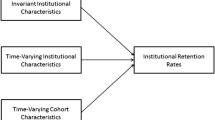Abstract
Universities establish various first yearprograms designed to assist students in thetransition from high school. American researchfocussing specifically on first yearadjustment, and general models of educationaloutcomes, suggest that early adjustment resultsin positive outcomes such as relatively highgrades and credit completion. An examinationof students entering York University in TorontoCanada in 1995 shows, however, that earlyadjustment may have only a very slight impacton first year grades and completed credits andno implications for five year outcomes. Findings such as these may indicate thatstudents who do not make an early adjustment touniversity in Canada may not necessarily bedisadvantaged. The difference between thesefindings, research on American campuses, andthe assumptions of American models of studentoutcomes, may result from general differencesin the post-secondary experience in the twonations.
Similar content being viewed by others
References
Astin, A. (1991). Assessment for Excellence. Toronto: Collier Macmillan.
Braxton, J. and Brier, E. (1989). ‘Melding organizational and interactional theories of student attrition’, Review of Higher Education13, 47–61.
Dietsche, P. (1990). ‘Freshman attrition in a college of applied arts and technology of Ontario’, Canadian Journal of Higher Education20, 65–84.
Fidler, P. and Moore, P. (1996). ‘A comparison of effects of campus residence and freshman seminar attendance on freshman dropout rates’, Journal of the Freshman Year Experience8, 7–16.
Gilbert, S., Evers, F. and Auger, M. (1989). ‘University attrition differentiated: Rates and institutional influences’. Presented to the annual meetings of the Canadian Society for the Study of Higher Education, Quebec City.
Grayson, J. (1996). Under-and Over-Achievement in First Year.Toronto: Institute for Social Research, York University.
Grayson, J. (1997a). ‘Place of residence, student involvement, and first year marks’, The Canadian Journal of Higher Education27, 1–24.
Grayson, J. (1997b). ‘Academic achievement of first-generation students in a Canadian university’, Research in Higher Education38, 659–676.
Grayson, J. (1998). ‘Racial origin and student retention in a Canadian university’, Higher Education36, 323–352.
Grayson, J. (1999a). The Student Experience at York University: The Effects of Income, Race, and Gender Over Four Years. Toronto: Institute for Social Research, York University.
Grayson, J. (1999b). ‘Using surveys to measure “value added” in skills in four faculties’, Canadian Journal of Higher Education29, 111–142.
Grayson, J. (1999c). ‘The impact of university experiences on self-assessed skills’, Journal of College Student Development40, 687–700.
Huff, M., Cook, D. and Price, C. (1996). ‘The first five years of freshman seminars at Dalton College: Student success and retention’, Journal of the Freshman Year Experience8, 17–33.
Hyers, D. and Joslin, M. (1998). ‘The first year seminar as a predictor of academic achievement and persistence’, Journal of the Freshman Year Experience10, 7–30.
Levitz, R. and Noel, L. (1989). ‘Connecting students to institutions: Keys to retention and success’, in Upcraft, M. and Gardner, J. (eds.), The Freshman Year Experience. San Francisco: Jossy-Bass.
Pascarella, E., Edison, M., Nora, A., Hagedorn, L. and Terenzini, P. (1996). ‘Influence on students' openness to diversity and challenge in the first year of college’, Journal of Higher Education67, 174–195.
Pascarella, E., Duby, P. and Iverson, B. (1983). ‘A test and reconceptualization of a theoretical model of college withdrawal in a commuter institution setting’, Sociology of Education56, 88–100.
Pascarella, E. and Chapman, D. (1983). ‘A multi-institutional path analytic validation of Tinto's model of college withdrawal’, American Educational Research Journal20, 87–102.
Pascarella, E. and Terenzini, P. (1991). How College Affects Students. San Francisco: Jossey Bass.
Pascarella, E. and Terenzini, P. (1981). ‘Residence arrangement, student/faculty relationships, and freshman-year educational outcomes’, Journal of College Student Personnel22, 147–156.
Pascarella, E., Duby, P., Miller, V. and Rashner, S. (1981), ‘Pre-enrollment variables and academic performance as predictors of freshman year persistence, early withdrawal, and stopout behaviour in an urban, nonresidential university’, Research in Higher Education15, 329–349.
Terenzini, P.T., Springer, L., Yaeger, P.M., Pascarella, E. and Nora, A. (1996), ‘First-generation college students: Characteristics, experiences, and cognitive development’, Research in Higher Education37, 1–22.
Terenzini, P.T., Springer, L., Pascarella, E.T. and Nora, A. (1995). ‘Influences affecting the development of students' critical thinking skills’, Research in Higher Education36, 23–39.
Tinto, V. (1993). Leaving College. Chicago: University of Chicago Press.
Author information
Authors and Affiliations
Rights and permissions
About this article
Cite this article
Grayson, J.P. The consequences of early adjustment to university. Higher Education 46, 411–429 (2003). https://doi.org/10.1023/A:1027315020856
Issue Date:
DOI: https://doi.org/10.1023/A:1027315020856



